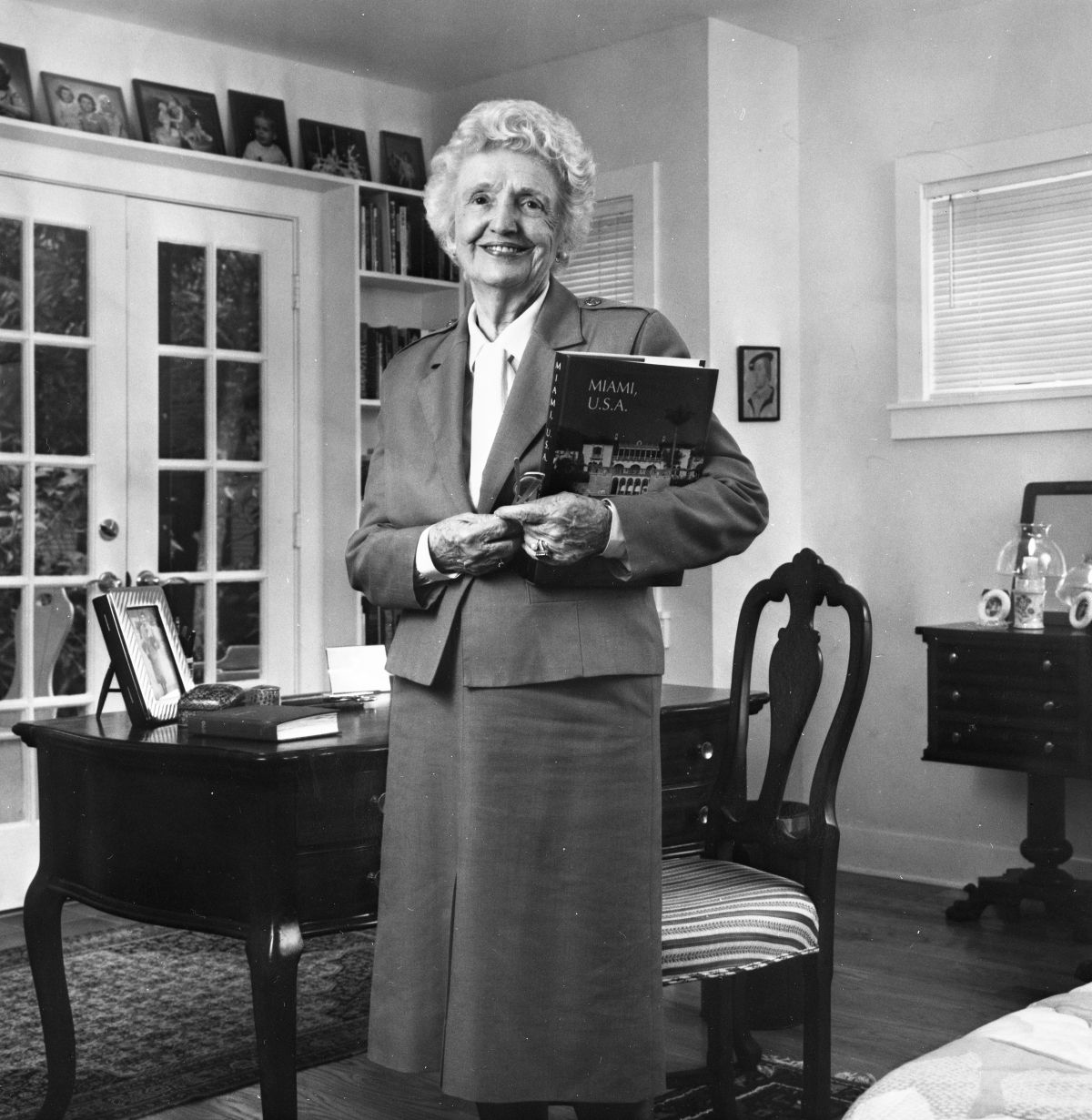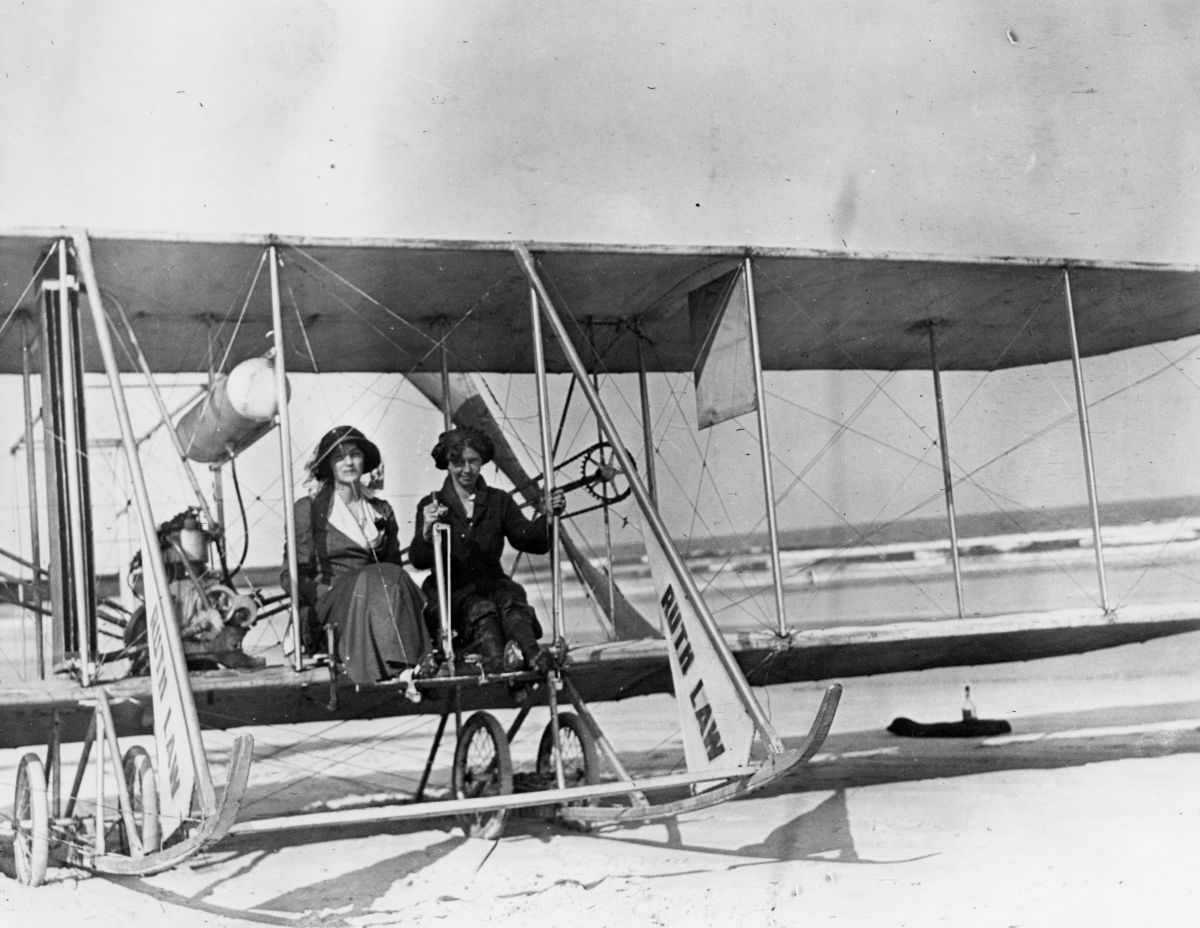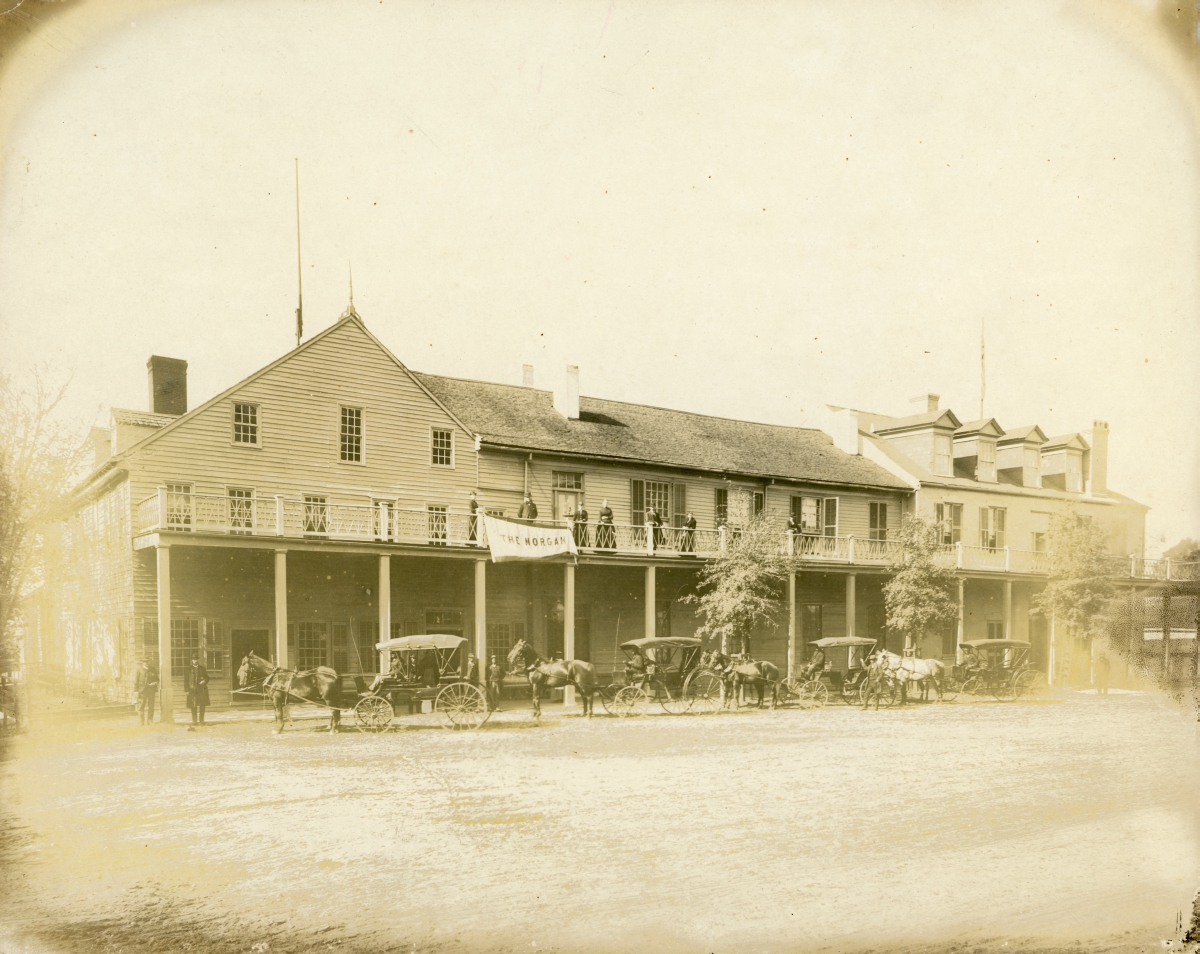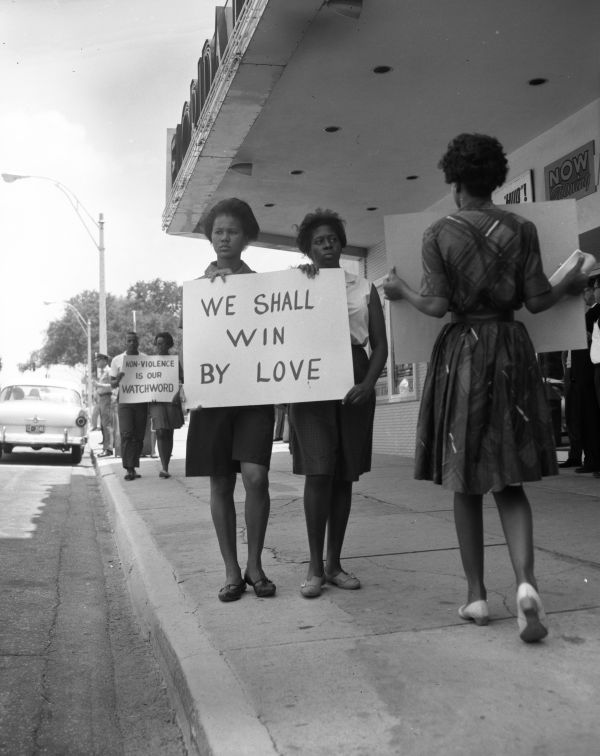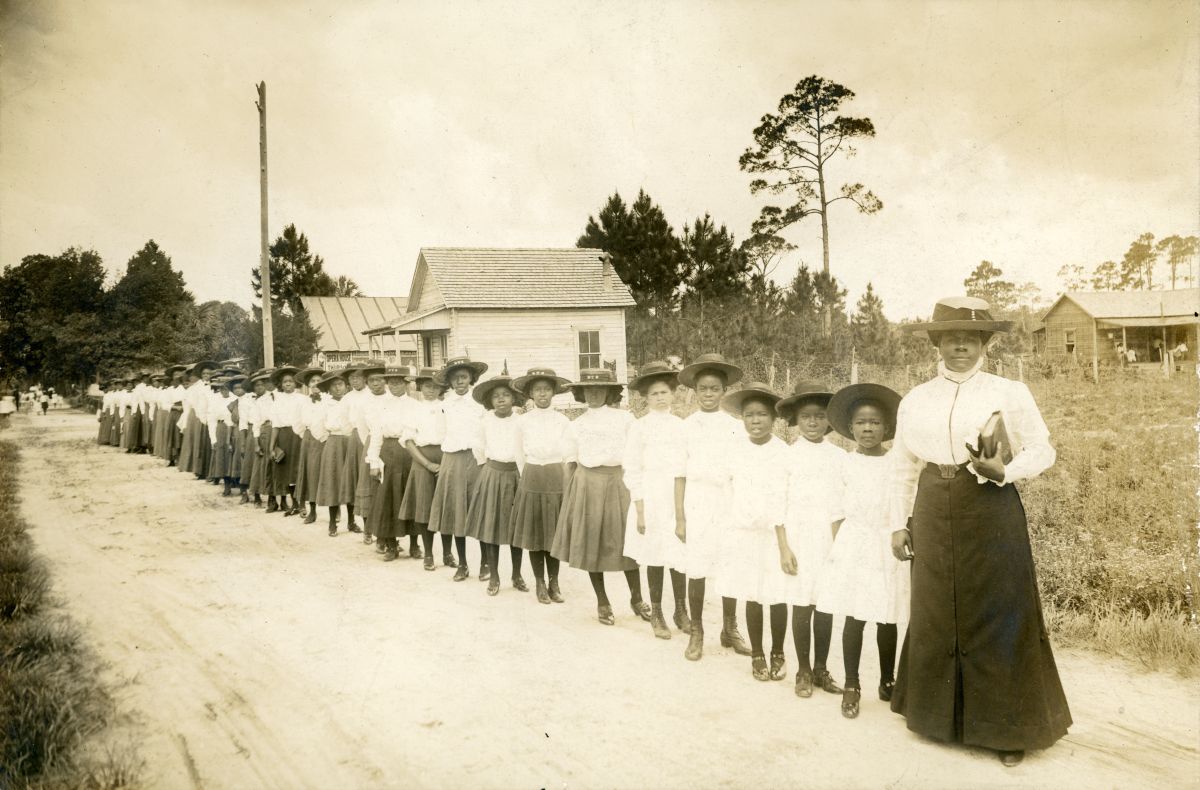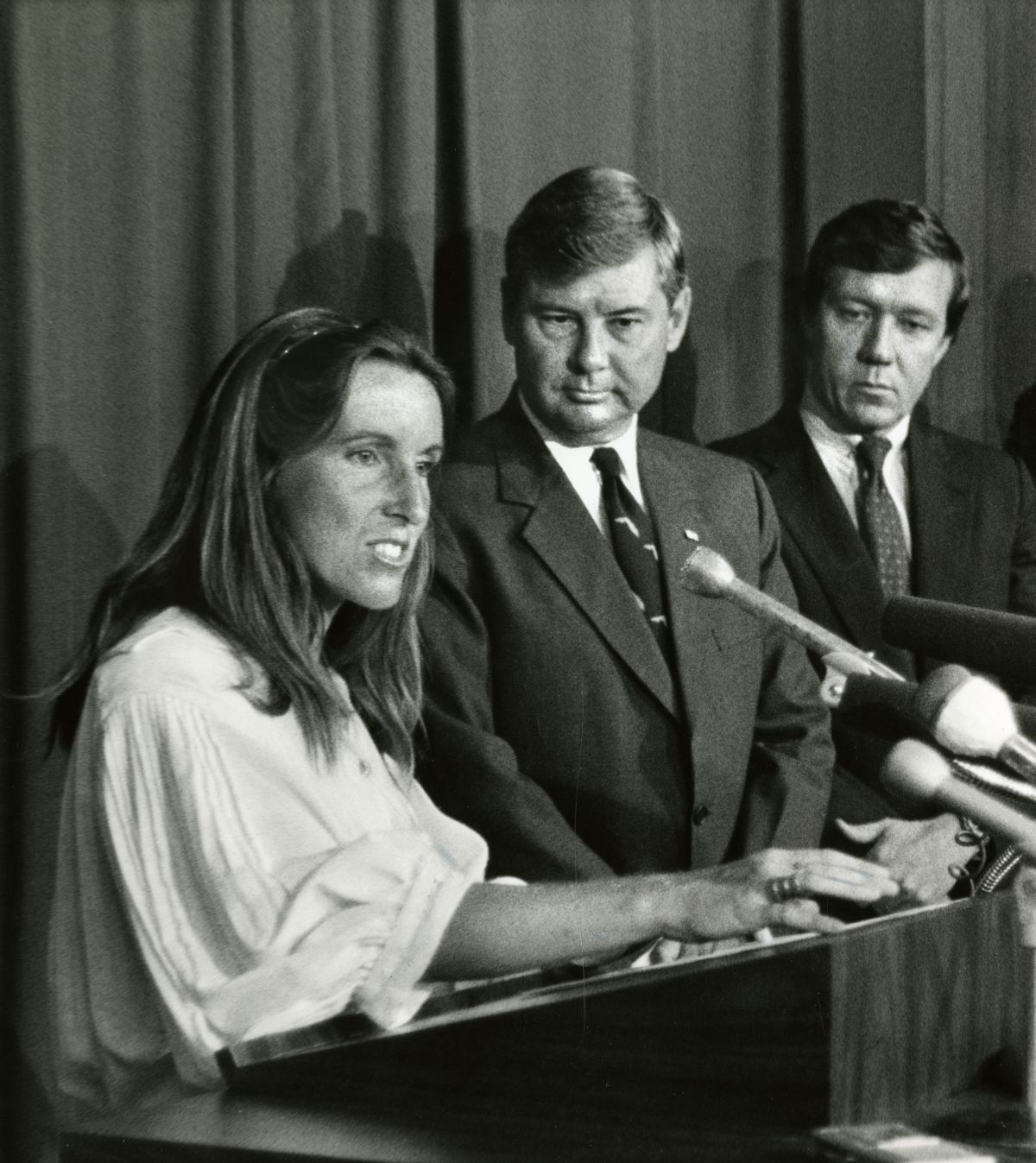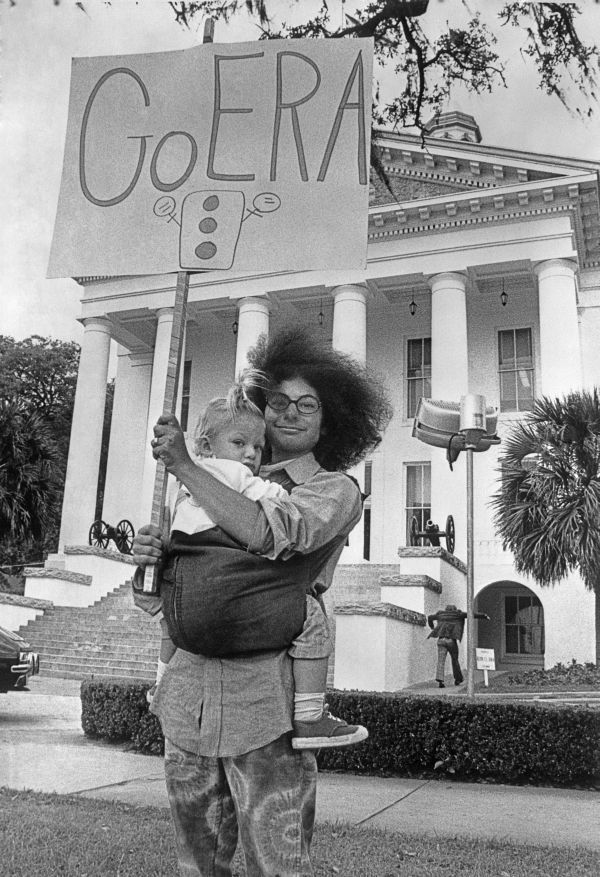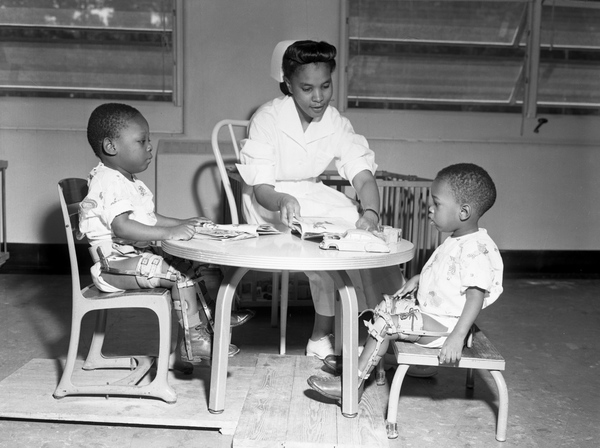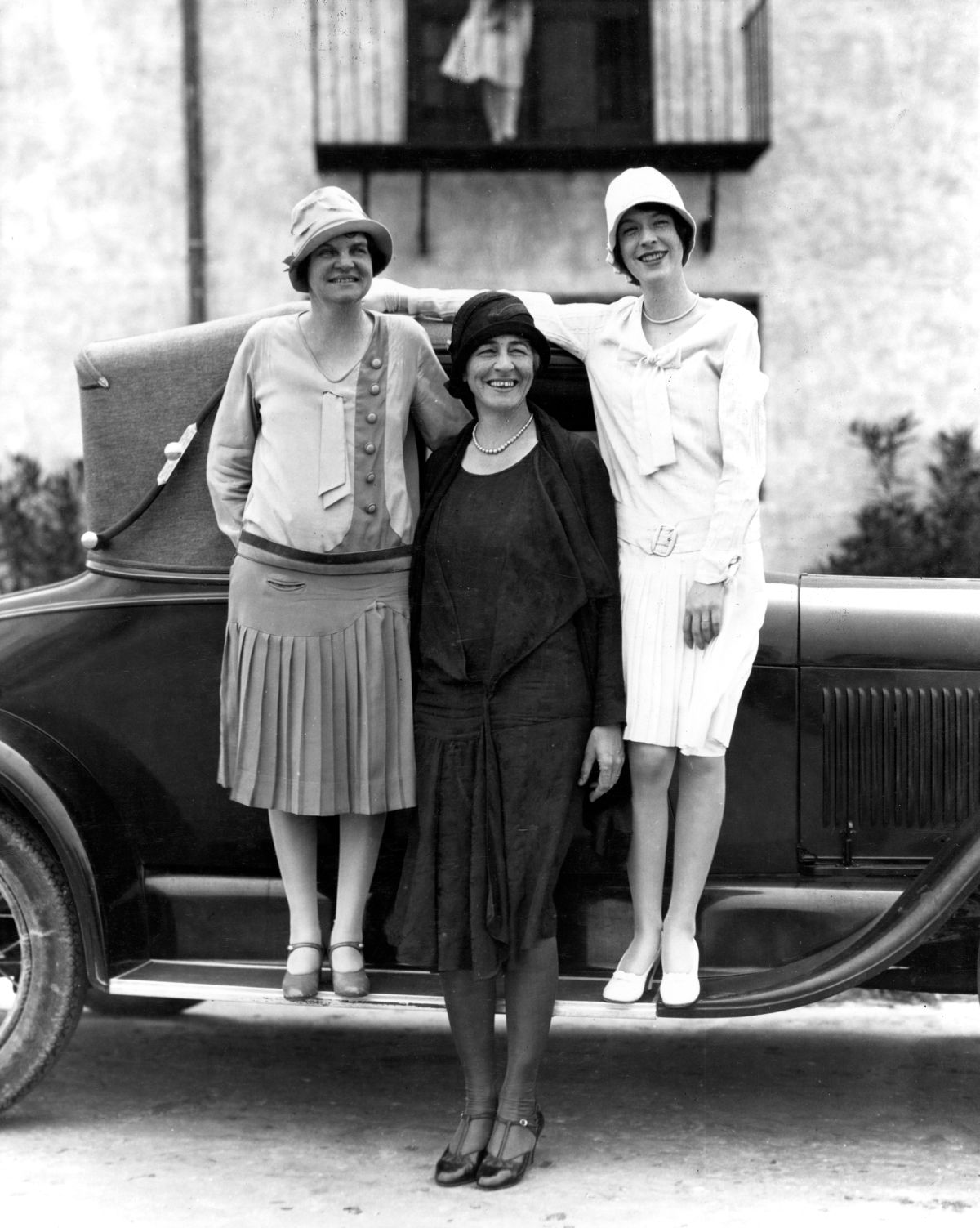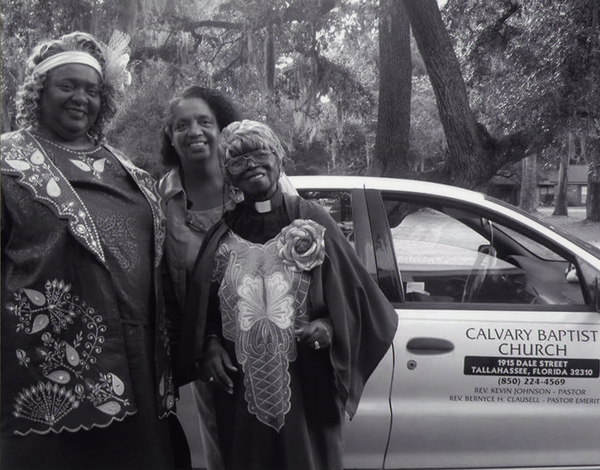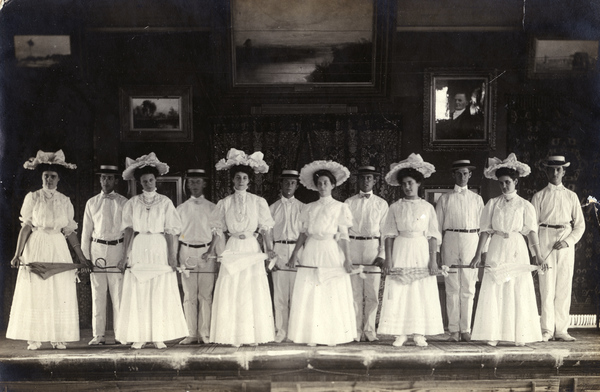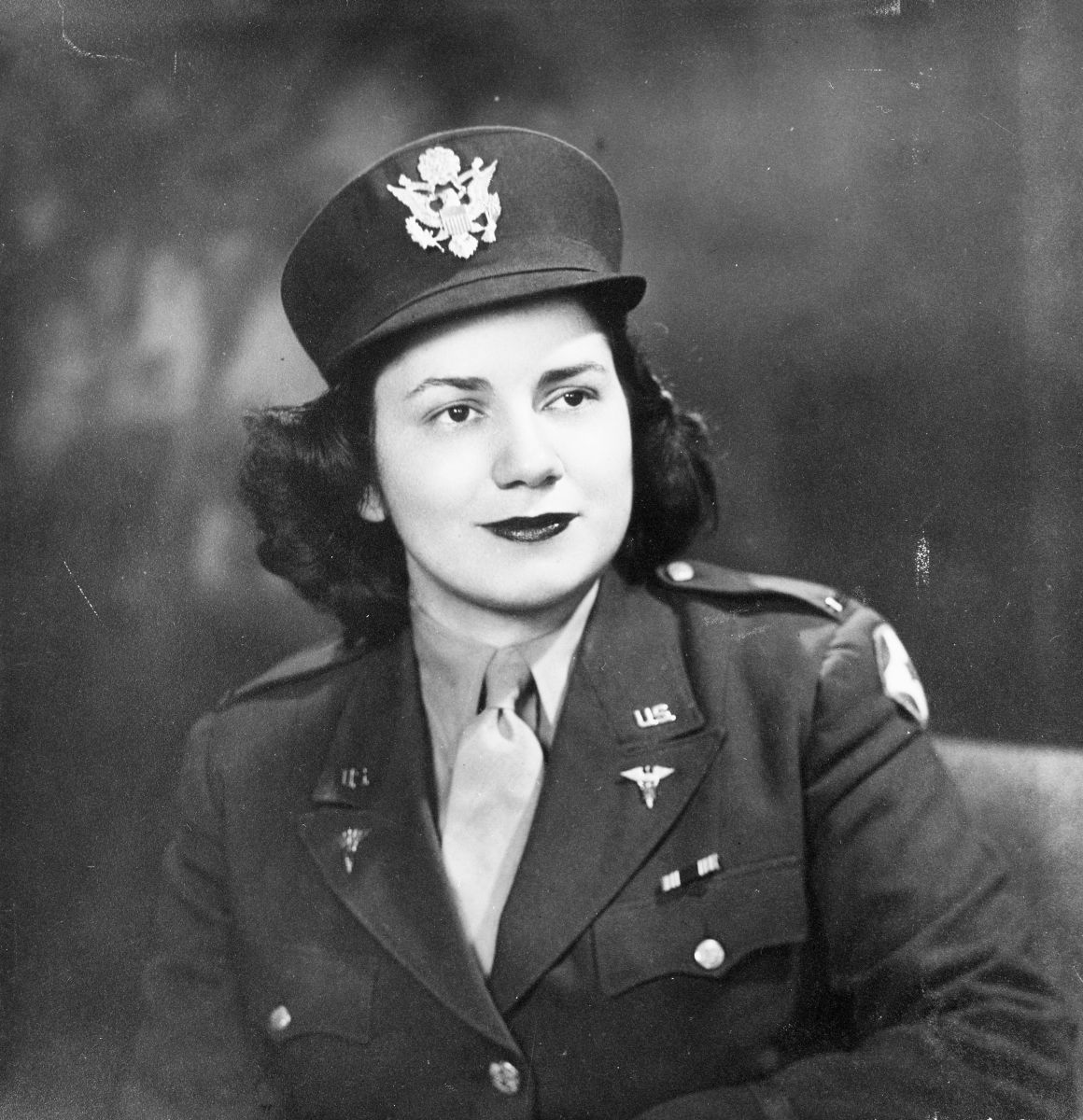Photo Exhibits
Photo exhibits spotlight various topics in Florida history, and are accompanied by brief text intended to place selected materials in historical context.
Women’s History in Florida
Here are just a few of the many images depicting topics in women's history in Florida. For more images, search the Florida Photographic Collection.
Women Authors
Image Number: N045303
Helen Muir holding the second edition of her book Miami, U.S.A., ca. 1990. She was a newspaper reporter and editor and the author of Miami history books.
Florida's rich heritage and unique natural landscapes have inspired many women novelists, historians and poets over the years. Zora Neal Hurston wrote about a girl coming of age in Florida in her 1937 novel Their Eyes Were Watching God; Marjorie Kinnan Rawlings was awarded a Pulitzer Prize for her novel The Yearling; and Marjory Stoneman Douglas drew attention to the plight of the Everglades and the importance of preserving it in The Everglades: River of Grass.
Women and Aviation
Image Number: RC07964
Aviatrix Ruth Law (right) and Mrs. Robert Goelet in a Wright Model B airplane at Daytona Beach, 1914.
In the early 20th century, Florida's flat landscapes and long stretches of beach attracted inventors, entrepreneurs and pioneer aviators who were interested in the possibilities of flight. Women received their pilot's licenses, tested their inventions and broke records on Florida's beaches just like their male counterparts. Florida native and aviatrix Jacqueline Cochran set records and was the first woman to break the sound barrier in 1952. Cochran proposed the creation of the Women Airforce Service Pilots (WASP) organization during World War II to help free male pilots for combat. WASPs trained other pilots and tested airplanes under Cochran's direction.
Women and Business
Image Number: MSC3460
The Morgan Hotel in Tallahassee was operated by Mary Archer from 1870 to about 1874 as the City Hotel. This photograph was taken by Alvan S. Harper around 1884.
Women have a long history of entrepreneurship and business management in Florida. In the 1800s, women owned and operated a number of hotels, restaurants, boarding houses and schools. A business directory for St. Augustine published in 1885 lists at least nine women business owners or managers. Mary Archer operated the Morgan Hotel in Tallahassee, and Mrs. R. J. Slager ran the Jewish Boarding House in Jacksonville. Eartha M. M. White founded Clara White Mission in Jacksonville to provide food and shelter for the homeless, and Sarah Ann Blocker cofounded a school that later became Florida Memorial University.
Women and the Civil Rights Movement
Image Number: PR05167
Two demonstrators holding a sign that reads "We Shall Win by Love" in front of the Florida Theatre in Tallahassee, ca. 1963.
The civil rights movement of the 1950s and 1960s was led and supported by many women throughout the state, fighting segregation and discrimination in schools, buses, restaurants and other spaces. Wilhelmina Jakes and Carrie Patterson started the Tallahassee Bus Boycott in 1956. Sisters Patricia and Priscilla Stephens founded the Tallahassee chapter of the Congress of Racial Equality in 1959, and organized sit-ins in the capital city. The Stephens sisters, Barbara Broxton and Angelina Nance were four of the eight students arrested and sentenced to jail time for holding a sit-in at a Tallahassee lunch counter in early 1960. M. Athalie Range, Daisy Young and Irvena Prymus were just a few of the other civil rights activists in Florida.
Women's Clubs
Image Number: PR78295
The Woman's Club at Vero gathered for the annual May breakfast, 1923.
The woman’s club movement of the Progressive Era saw women form many clubs to tackle important issues of the time. Women had very little power in politics, but these clubs gave them opportunities to present their ideas and take action in their communities. Women organized clubs to fight for equal suffrage, temperance, child welfare and environmental protection, locally and statewide. Florida women’s clubs were racially segregated like other institutions and organizations in the South under Jim Crow laws. Black women founded clubs and focused on many of the same issues as the segregated white women’s clubs. The Florida Federation of Women’s Clubs, the Florida Federation of Colored Women’s Clubs, the City Federation of Colored Women's Clubs of Jacksonville and the Florida League of Women Voters were a few of the women’s clubs operating in Florida in the early 20th century.
Women and Education
Image Number: N041432
Mary McLeod Bethune with her students at the Daytona Literary and Industrial Training School for Negro Girls in Daytona Beach, ca. 1911.
The teaching profession began accepting women into the field in the United States beginning in the mid-19th century. Teaching was one of the few jobs available to women at that time. Not only did teaching provide women with their own income, it also gave them the opportunity to improve their own education through teacher training schools and courses. Mary McLeod Bethune, one of Florida's most famous educators, started her own school in 1904 to educate African-American girls in Florida.
Women and Environmentalism
Image Number: MF0691
Laurie Macdonald, conservation chair for the Florida Sierra Club, endorsing U.S. Senate candidate Bob Graham (center) at a news conference in Tallahassee, 1986. George Sheldon, representing the League of Conservation Voters, stands at the right.
Land development in Florida during the 20th century often came at the expense of the state's natural environment. As Floridians became more aware of how poorly-planned development and unsustainable resource use impacted local ecosystems, women formed clubs and organizations and led grassroots campaigns to raise awareness and stop these practices. Women orchestrated protests, letter writing campaigns and public meetings to speak out against projects that would harm the environment. In Florida, Marjorie Harris Carr, May Mann Jennings, Jeanne Bellamy, Marjory Stoneman Douglas and Mary Grizzle are just a few of the women who worked to protect Florida's environment.
Women and the Equal Rights Amendment
Image Number: PR02863
Marlene Taylor holds her daughter, Stacy, while supporting the Equal Rights Amendment in front of the Florida Historic Capitol in Tallahassee, 1973.
From 1972 to 1982, Florida lawmakers debated whether to ratify the Equal Rights Amendment (ERA). Floridians' response to the ERA mirrored the national divide over the amendment's message on gender equality. Gwen Cherry, Elaine Gordon and Roxcy Bolton were outspoken advocates of the ERA in Florida, organizing marches and letter-writing campaigns to convince state politicians to vote for it. As the 1982 deadline to ratify the amendment approached, Florida was in the national spotlight as the state senate held its final vote on the amendment during a special session. Florida's House of Representatives had already approved the measure, but it failed in the Florida Senate by a vote of 16 to 22. Nationwide, the amendment lacked ratification by only three states to officially become part of the Constitution.
Women and Folklife
Image Number: FP83160B
Folklorist Nancy Nusz interviews Mr. Ramesch from the Mandeer Restaurant at the 1983 Florida Folk Festival in White Springs.
Women have been documenting Florida folklife since the 1930s when the Works Progress Administration's Federal Writers' Project sent fieldworkers around the state to collect folk stories, songs and traditions. Zora Neale Hurston, Carita Doggett Corse and Viola Muse were some of these early women fieldworkers. In 1955, Thelma Boltin became director of the Florida Folk Festival and brought national attention to Florida's folk culture. The Florida Folklife Program was established in 1979, and folklorists Nancy Nusz, Peggy Bulger, Brenda McCallum, Doris Dyen and many other women researched and documented the state's folk traditions through the program.
Women and Journalism
Image Number: FFL1274A
A reporter from WTXL interviews a man in Tallahassee, 1985.
Some of the earliest women reporters wrote for newspaper society columns, which shared information about fashion, food and local happenings. But it wasn't long before the profession hired women to report about all topics, including sports, politics and war. Florida has had many prominent women journalists, including Marjory Stoneman Douglas, Barbara Landstreet Frye, Lucy Morgan, Hettie Cobb, Helen Muir and Eve Alsman Fuller. Pioneering broadcast journalist Molly Turner became Florida's first woman television news anchor in the 1960s.
Women and Law
Image Number: N045925
Portrait of Louise Rebecca Pinnell in Jacksonville, ca. 1920. She worked as an attorney for the Florida East Coast Railway in St. Augustine for 25 years and then in a private practice until 1958.
Women have practiced law in Florida since 1898, when Louise R. Pinnell became Florida's first woman lawyer admitted to the Florida Bar. Since then more women have joined the bar each year and gone on to become lawyers, judges and Florida Supreme Court justices. In 1985, Rosemary Barkett was appointed Florida's first supreme court justice by Governor Bob Graham. She also went on to become Florida's first female chief justice. Other notable women of the bench and bar in Florida include Janet Reno, Gwen Cherry, Anna Brenner Meyers, Bernice Gaines Dorn, Dorothy Douglas and Rebecca Bowles.
Women and Medicine
Image Number: TD00035
Nurse Grace Kyler working with polio victims at the FAMU Hospital in Tallahassee, 1953.
Women practiced traditional and alternative medicine in Florida since the 19th century at least. Midwives delivered almost all of the children in Florida, especially in African-American communities. Florida’s first college-educated women physicians arrived in the 1880s, when Mary Jane Safford and Fidelia Jane Merrick Whitcomb moved to the state and started practicing medicine in Tarpon Springs. Ruth Bryan Owen, Florence Simpson and Sarah Kaplan are a few of the women who stepped up to serve as nurses during the world wars. In the early 20th century, Henriette Martens practiced homeopathic medicine and was one of the first doctors in South Florida. Mary Josie Rogers opened her Daytona Beach practice in 1907, with a focus on holistic medicine. Susie Jim Billie was a highly-respected Seminole medicine woman during the 20th century. From the late 1940s through the 1960s, nurse Betty Mae Jumper traveled around southern Florida helping to treat members of the Seminole Tribe.
Women and Politics
Image Number: RC02972
Ruth Bryan Owen (center) with her secretary and driver standing in front of her campaign car "The Spirit of Florida" during her run for the U.S. House of Representatives, ca. 1929.
Florida women were running for and serving in public offices throughout the state before they had the right to vote in national elections. Marian Newhall Horwitz, for example, was elected mayor of Moore Haven in 1917, making her Florida's first woman to serve in that role. In 1920, right after the women's suffrage amendment went into effect, several women were elected to county offices in Florida, including Eleanor Floyd as tax assessor of Franklin County, and Agnes Ballard as superintendent of public instruction in Palm Beach County. In 1929, Ruth Bryan Owen became the first woman from Florida to serve in the U.S. House of Representatives, while Edna Giles Fuller became the first woman to serve in the state legislature. Beth Johnson became the first woman elected to the Florida Senate in 1962. Gwen Cherry was the first Black woman elected to Florida House of Representatives in 1970, and Carrie Meek served as the first Black woman in the Florida Senate starting in 1982. To date, Florida has been represented in the U.S. Senate by one woman, Paula Hawkins, who served from 1981 to 1987.
Women and Religion
Image Number: DG01886
Reverend Bernyce H. Clausell (right) with her daughters Mary Clausell Lewis (left) and Minister Aaronetta Clausell Frison in Tallahassee, ca. 2014.
Religion and spirituality are important parts of community life in Florida. Women are involved at all levels of religious life, including participating in worship services, volunteering in the community and serving as church leaders. Dozens of women are listed as church leaders in the Works Progress Administration's Historical Records Survey from the 1930s. Other religious leaders in Florida include Bernyce Clausell, who became pastor of Calvary Baptist Church in Tallahassee in 1978, and Leona Cooper of Miami, who worked to involve more women and members of the Black community in the Catholic Church.
Women and Sports and Recreation
Image Number: c009829
Members of the All-American Girls Baseball League doing calisthenics in Opa-locka, 1948.
Florida's year-round sunshine attracts many professional and amateur women athletes to the state. The All-American Girls Professional Baseball League brought teams to Florida for spring training during the 1940s. The league was created during World War II to maintain the popularity of the sport while many professional male players were away at war. Tennis, golf, basketball and water sports have also been fun pastimes for women living and vacationing in the Sunshine State.
Women and STEM
Image Number: N041277
JoAnn Hardin Morgan, director for safety and mission assurance at NASA, poses with a model of the Space Shuttle in 1995.
Women’s participation in the fields of science, technology, engineering and math (STEM) is not a new phenomenon, but their contributions have often been ignored or forgotten. The Space Race of the 1950s and 1960s saw the acceptance of more women into STEM fields as the country strived to be the first to land a man on the Moon. In 1983, Sally Ride became the first American woman astronaut in space, and more than 60 American women have followed since then. Mae Jemison was the first Black woman in space in 1992, traveling on the Space Shuttle Endeavor, and the next year Ellen Ochoa became the first Hispanic woman in space when she served aboard the Space Shuttle Discovery.
Women and the Suffrage Movement
Image Number: KOR0479
The cast from the Koreshan Unity play "Women, Women, Women, Suffragettes, Yes" in Estero, ca. 1920.
The women's suffrage movement in the United States began in the mid-19th century and culminated in the adoption of the 19th Amendment to the U.S. Constitution on August 26, 1920. Though women of color were granted the right to vote with the amendment, they were often turned away from polls, accused of illegally voting and faced other forms of intimidation when trying to exercise their rights. Despite these obstacles, Black women leaders like Mary McLeod Bethune and Eartha M. M. White worked to register Black Floridians to vote and encouraged voter turnout in the November 1920 election.
Women and World War II
Image Number: MS26418
Second Lieutenant Sarah Kaplan of the Army Medical Corps, ca. 1940. She served as a nurse under General Patton in the Battle of the Bulge.
Women joined the military and served in noncombat positions as nurses and yeomen during both world wars. During World War II, the Women's Army Auxiliary Corps (WAAC) opened a training facility in Daytona Beach. The first WAAC recruits arrived in October 1942, and over the next two years approximately 20,000 women received training there. Back on the home front women also aided the war effort by helping to administer the government's rationing system, growing their own victory gardens, collecting scrap metal for recycling and working in defense-related industry jobs typically done by men.
For more photographs of women in Florida, see Women Who Serve.

 Listen: The Gospel Program
Listen: The Gospel Program